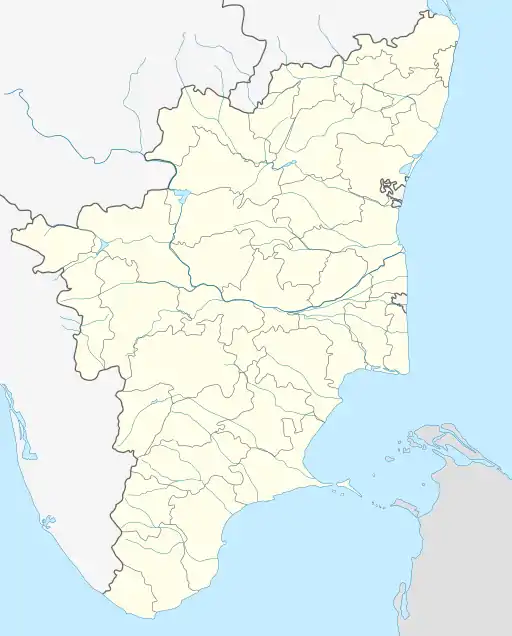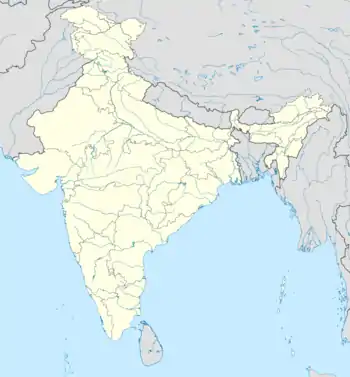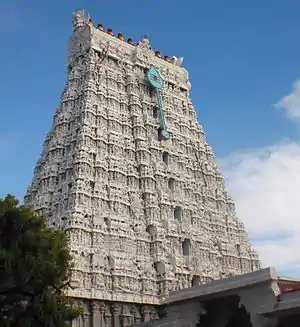Thiruchendur
Tiruchendur is a panchayat town located in the southern tip of India, in the Thoothukudi district of Tamil Nadu. It is home to Thiruchendur Murugan Temple, also known as Arulmigu Subramaniaswamy Temple which is a Second of Arupadai veedugal (Abodes of Murugan) and one of the ancient Hindu temples dedicated to Lord Muruga.[2][3][4] Tiruchendur is well-connected by road and rail with the rest of Tamil Nadu and India and the nearest railway station is Tiruchendur railway station. Tiruchendur is just 53 km from Tirunelveli.
Tiruchendur
Tirucheer Alaiwai | |
|---|---|
Town | |
 Tiruchendur beach | |
 Tiruchendur  Tiruchendur | |
| Coordinates: 8.4833°N 78.1167°E | |
| Country | |
| State | Tamil Nadu |
| District | Thoothukudi |
| Government | |
| • Type | Town Panchayat |
| Elevation | 3 m (10 ft) |
| Population (2011)[1] | |
| • Total | 32,171 |
| Demonym(s) | Chendoorkaran, Chendooran |
| Languages | |
| • Official | Tamil |
| Time zone | UTC+5:30 (IST) |
| PIN | 628215 |
| Telephone code | 04639 |
| Vehicle registration | TN-92( TN-69 till Jun17,2015) |
| Nearest city | Thoothukudi |
| Sex ratio | 1000 : 1018.58 ♂/♀ |
| Literacy | 79% |
| Nearest Airport | Thoothukudi |
| Lok Sabha constituency | Thoothukudi Formerly with Tiruchendur |
| Rajya Sabha constituency | Tiruchendur |
| Website | www |
Etymology
Thiruchendur, a temple town like many towns in the state of Tamil Nadu, is named after the red soil nature of the town Senthoor. Legend has it that the name Tiruchendur originated from Thiru,meaning sacred, because it was a battleground for Lord Muruga, and Senthoor, meaning red place, because of the bloodiness of the battle.
Geography


Tiruchendur is located on the south–eastern coast of India in the south–eastern part of Tamil Nadu. It is located on the south-eastern shoreline of Tamil Nadu overlooking the Bay of Bengal. The soil type is majorly Clay, Red soil. The suburban villages surrounding the town contain arid, red soil forests that are densely planted with palm trees, cashew plantations, and other crops part of the region.[5]
Demographics
As of the 2001 Indian census, Tiruchendur had a population of 29,330.[6] Males constitute 50% of the population and females 50%. Tiruchendur has an average literacy rate of 79%, higher than the national average of 59.5%. Male literacy is 82%, and female literacy is 76%. In Tiruchendur, 12% of the population is under 6 years of age.
Public Administration
Tiruchendur Town is managed by Tiruchendur Town Panchayat which has 21 wards. It is also a Taluk headquarters, and there are 10 local bodies and 46 villages comes under the jurisdiction of Thiruchendur taluk.[7] The District Munsiff Court and Judicial Magistrate Court are located in the town.[8] The Revenue Department is administered by Tiruchendur Tashildar and the police administration by the Deputy Superintendent of Police, Tiruchendur.
Transportation
The town is connected by rail and road. The Tuticorin Airport is about 40 kilometres (25 mi) from Thiruchendur, 55 km (34 mi) from Tirunelveli, and 171 km (106 mi) from Madurai.[9] Currently, SpiceJet and Air Carnival operate three inbound and outbound flights to Chennai. There are bus connections to Aruppukkottai, Ettayapuram, Tuticorin, Kovilpatti, Sankarankovil, Madurai, Tirunelveli, Vilathi Kulam and major cities of Tamil Nadu. The town is connected to Tirunelveli by a broad-gauge train track, with a train station at Thiruchendur. The Chendur Express train runs daily between Chennai Egmore Junction and Tiruchendur. Passenger train services are also available between Tirunelveli and Tiruchendur.
Education
Colleges
- Aditanar College of Arts and Science, Tiruchendur
- Dr. Sivanthi Aditanar College of Education, Tiruchendur
- Dr. Sivanthi Aditanar College of Engineering, Tiruchendur
- Dr. Sivanthi Aditanar College of Nursing
- Dr. Sivanthi Aditanar College of Physical Education, Tiruchendur
- Dr. Sivanthi Aditanar Teacher Training Institute, Tiruchendur
- Govindammal Aditanar College for Women, Tiruchendur
- Wavoo Wajeeha women's college of Arts and Science.
Schools
- Kayalpattanam Arumuganeri Higher Secondary School
- Govt Women Hr.Sec.School
- Hindu Hr.Sec.School
- Senthil Murugan Govt. Girls Hr. Sec. School
- Sri Ramakrishna Higher Secondary School
- Anita Kumaran Matric Higher Secondary School
- Aparna matic highersecondaey school
- Mary Ann Best Girls Higher Secondary School
- Bishop Azaria memorial Higher secondary school
- Ambrose Boys Hr. Sec. School
- Elliot Tuxford Girls Higher Secondary School
- LK Higher Secondary School
- Senthil Kumaran Matriculation School
- Kanchi Sri Sankara Academy Matric Higher Secondary School
- Pearls public International School
- St. Thomas Higher Secondary School
- Senthil Raja Primary and Secondary School
- Saravanayar Primary School
- Kamlavathi Higher Secondary School
- Salma Matriculation School
- Wisdom Public School
- Arulmigu Senthil Aandavar Government Boys Higher Secondary School
- Zubaidha Higher Secondary School
Religion
An epic poem composed in the 17th century, known as Kapadapuram, tells that Muruga killed the demon Surapadman after a six-day battle.The religion followed here is mostly Hindu and with important presence of a Christian Catholic community and nearby town called kayalpatnam has 90% Muslim population says muslims around70,000 people there.[10]
Temples
Tiruchendur Murugan Temple



Tiruchendur Murugan Temple is an ancient Hindu temple dedicated to Lord Muruga at the site of the battle. It is one of the six major abodes, or sacred temples, of the Kaumaram religion. Soorasamharam, a reenactment of the victory over Sarapadman, and Kanda Shasti Kavasam, a devotional song in praise of Lord Muruga are performed at the temple.
The temple, which is built near the seashore, measures 91 m (299 ft) north to south, 65 m (213 ft) east to west, and has a seven-tier gopuram, or tower gate, that is 42 m (138 ft) high.[11] The principal entrance faces south, and opens into the first of two prakarams, the first of which is lined with rows of Yalis. The inner sanctum of the temple is in a cave and the main deity, or moolavar, is Murugan as a saintly child, portrayed in a granite carving.[10]
Naazhi Kinaru, a sacred well fed by a freshwater spring, is located 100 m (330 ft) south of the temple. Devotees undergo a ritual cleansing by bathing in water from the well after bathing in the ocean.[10]
Dutch occupation of the Thiruchendur Temple
The Murugan temple at Thiruchendur was occupied by the Dutch East India company from 1646 to 1648, during the course of their war with the Portuguese. The local people tried to free their temple, with no success. The Dutch finally vacated the temple on orders from the Naik ruler. However, while leaving, they removed the idol of the main deity of the temple, and took it with them. While they were sailing away, they encountered a strong storm and realised their mistake of stealing the idol. They dropped the idol in the middle of the sea and seen the storm stopped immediately. Later, Lord Senthil Aandavan appeared in a dream to Vadamaliyappa Pillai, an ardent devotee of Lord Muruga, and revealed the place in the sea where the idol had been abandoned. Vadamlaiyappa Pillai and Athitha Nadar, a sponsor of services in the Thiruchendur temple, went to the spot in a fishing boat and retrieved the idol in 1653. The story is shown in paintings inside the temple[12]
Other temples
- Kulasai Muthuramman Kovil , kulasekarapattinam dasara festival.
- Avathara Pathi, the site where Vishnu incarnated as Ayya Vaikundar and rose from the sea.
- Sri Ponvandu Aiyanar temple, in the village of Nainarpattu, near Thiruchendur.
- Chettiyapathu Sri Ainthu Veettu Swami Temple is situated at Udankudi, 2 km (1.2 mi) from Thiruchendur.
Mosques
- Mohideen Masjid
Festivals and rituals
Festivals are celebrated throughout the year at the temple including Brahmothsavam in the month of Maasi, Vasanthotsavam for 10 days in Chithirai, Vaikasi Visakam for 12 days and Skandha Sashti in Aippasi. There are two Maha Utsavams called Aavani perunthirunaal and Maasi perunthirunaal conducted and celebrated during Aavani and Maasi. These 12-day festivals occur twice every year.[13]
Masi Thiruvizha

Several lakh of people congregate for Masi Thiruvizha, a 12-day festival at Thiruchendur. The Kayamozhi Athitha Nadarhal Arakattalai Mandahapadi committee organises functions on the sixth and seventh days of the festival. On the tenth day of the festival, the presiding Lord of the Thiruchendur temple makes a special appearance in Thirunelveli Dakshinamara Nadar Sangam, in Sannidhi Street.
Several thousand devotees worship at the Masi Magam festival of the Sri Subramaniawamy temple at Tiruchendur. The festival was inaugurated by the Athitha Nadar clan several centuries ago and includes ritual performances, like Pali-vidalai eridhal.
Ippasi Lord Subramaniya's marriage ritual
In the month of Aippasi, when the ritual for Lord Subramaniya's marriage is performed, Athitha Nadars perform the ritual for the groom side, offering Thirumangalyam and the wedding feast. The bride's side wedding feast is arranged by Nattathi Nadars the next day.
Politics
The Tiruchendur assembly constituency was part of the Tiruchendur (Lok Sabha constituency) until 2009.[14] After dissolution of the Lok Sabha constituency in May 2009, the constituency was aligned with the Tuticorin Lok Sabha constituency. The current member of the legislative assembly (MLA) to Tamil Nadu assembly, elected by the general election 2011, is Anitha R. Radhakrishnan of Dravida Munnetra Kazhagam.[15]
See also
References
- "Census of India: Search Details". censusindia.gov.in. Archived from the original on 4 March 2016. Retrieved 5 September 2016.
- "Welcome To Lord Murugan.com Home Page". Lordmurugan.com. Retrieved 7 September 2015.
- "Tiruchendur". Thoothukudi.nic.in. Retrieved 4 September 2016.
- "Murugan Temple Tiruchendu Article". blessingsonthenet.com. Retrieved 19 November 2018.
- "Historical Incidents of 1639-1651". tiruchendur.org. Retrieved 19 November 2018.
- "Census of India 2001: Data from the 2001 Census, including cities, villages and towns (Provisional)". Census Commission of India. Archived from the original on 16 June 2004. Retrieved 1 November 2008.
- http://www.census2011.co.in/data/subdistrict/5868-tiruchendur-thoothukkudi-tamil-nadu.htm. Missing or empty
|title=(help) - "Taluk Courts | Official Website of District Court Of India". ecourts.gov.in. Retrieved 22 May 2017.
- "(TCR) Tuticorin Airport". flightstats.com. Retrieved 7 September 2015.
- Clothey, Fred W. (1978). The Many Faces of Murukan̲: The History and Meaning of a South Indian God. Walter de Gruyter. pp. 121–. ISBN 978-90-279-7632-1. Retrieved 5 September 2016.
- Knapp, Stephen (1 January 2009). Spiritual India Handbook. Jaico Publishing House. pp. 387–. ISBN 978-81-8495-024-3.
- "Dutch adventure of 1648". tiruchendur.org. Retrieved 19 November 2018.
- Pillai, J.M. Somasundaram. "Tiruchendur's Annual Festivals". tiruchendur.org. Retrieved 19 November 2018.
- "List of Parliamentary and Assembly Constituencies" (PDF). Tamil Nadu. Election Commission of India. Archived from the original (PDF) on 4 March 2009. Retrieved 5 September 2016.
- "15th Assembly Members". www.assembly.tn.gov.in. Retrieved 19 November 2018.
External links
- Tiruchendur Nagara Viduthi
- Photos of Tiruchendur Nagara Viduthi
- Thiruchendur Murugan Kovil
- Chendur Murugan Kovil
- Tiruchendur Muruga
| Wikimedia Commons has media related to Thiruchendur. |
